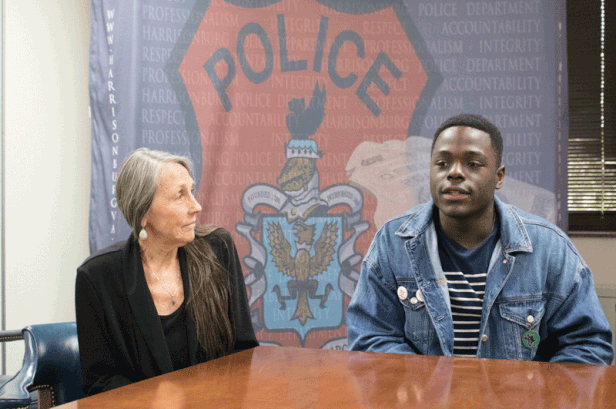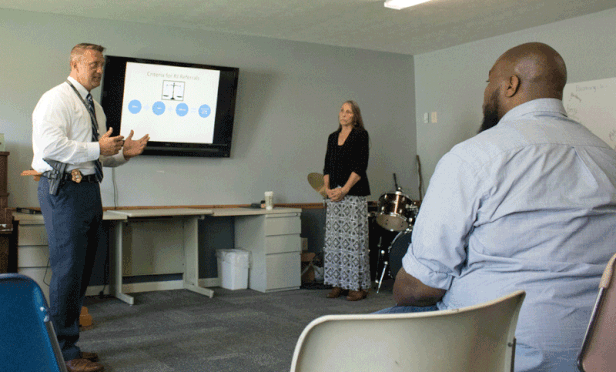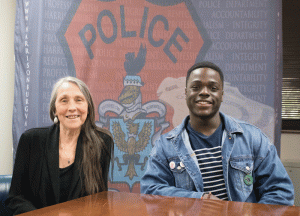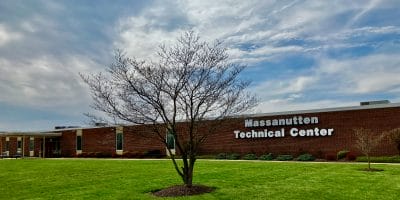By Ryan Alessi
Pierre Mbala and two friends were headed to get pizza on an overcast, chilly Thursday in late March, 2018. On the way, they stopped at a convenience store for a soda or maybe some candy, and to taste the freedom that comes with being 17.
Mbala’s friends made their purchases and walked outside. Trailing behind, Mbala stuffed a bag of AirHeads, one of Skittles and another of Starbursts into his right jacket pocket before walking out the front door. He knew the manager. And he assumed he wouldn’t get caught.
About five minutes later, a police cruiser pulled up across the street and two officers got out. Mbala’s body tensed. They were there for him, he suspected. As the officers started toward the boys, his panic deepened.
Mbala stood up and began to walk away. An officer called for him to stop, which he did. One of the officers, a trainee, asked Mbala if he had anything that didn’t belong to him. Mbala bashfully emptied his pockets. The officer explained that the store’s video camera recorded Mbala shoplifting the candy and that the store’s owners would press charges. Criminal charges. A criminal record.
“Is there any other way?” he asked.
In 2004, when he was three years old, Mbala’s family moved to the United States from the Democratic Republic of Congo. He established himself as a strong student at Harrisonburg High School, where he played football and was working on completing the Valley Scholars program after being selected in 8th grade. Valley Scholars is aimed at area students who, upon completing the requirements at high school graduation, get scholarships to JMU. Criminal charges, however, would disqualify him.
Criminal charges could also complicate his path to citizenship and his immigration status – not to mention his biggest goal: acceptance into the even more prestigious Centennial Scholars Program, which could lead to a full scholarship to JMU, where he planned to pursue an engineering degree.
Everything — his present and his future — seemed to be crumbling, all because of his decision to steal three bags of candy.
Mbala looked at the officers, then desperately into the store window to try to catch the manager’s eye.
“I had never been in a situation like that,” Mbala said. “So my voice was shaking even though I was trying to not make my voice shake. My hands were trembling. I couldn’t stay still. And I kept on looking back into the store just to like see if could make the manager see that I was honestly sorry.”
Enter restorative justice
Harrisonburg police officers are now trained to look for opportunities to hold people accountable for crimes using alternatives to jail and the courts. One of those alternatives is restorative justice, a practice the Harrisonburg Police Department has embraced so fully that it’s at the cutting edge of this approach community law enforcement.
Restorative justice is a process by which the offender, the victim, a police officer and others in the community come together to delve into the harm caused by a crime, the underlying reasons for it, and its effects.
Though not always successful, this intense process can be transformative for participants.
There’s no definitive criteria for who might qualify, and specific crimes don’t automatically flag a case for referral to restorative justice. Since 2015, the Harrisonburg Police Department has referred offenders to restorative justice in cases ranging from shoplifting and property damage to more serious crimes like assaulting a police officer, felony larceny, burglary and sexual assault.
Police Chief Eric English, who was part of a team at the Richmond Police Department that used restorative justice to address student discipline issues in schools, described the practice as a different approach to law enforcement
And, English said, when successful, it can keep people from falling into a cycle of crime, jail time and recidivism, and avoid the long-term effects that a criminal record can have on employment or getting into college.
“It’s just like a cultural change you have to make in your organization,” English said. “When you come into policing, one thing they tell you is that your job is to lock people up. And we get the mentality that that’s what we’re supposed to do.”
With support from the Commonwealth’s Attorney’s office, the Harrisonburg Police Department has been using a restorative justice process for select cases in which the offender demonstrates a willingness to accept responsibility for the harm they’ve caused and the victim also agrees to both face the offender and work with them through the process. It is one of few police departments — if not the only one in the country — to have a restorative justice program open to handling all types of cases: misdemeanors, felonies, adult and juvenile.
“I Google every couple of months and I haven’t found another one yet,” said Wonshé, a restorative justice practitioner who works with the department. (Wonshé goes by just a single name.)
English and practitioners like Wonshé caution that restorative justice can’t replace the traditional criminal process. And it can’t be converted into a one-size-fits-all mold. But when conditions are right and participants fully commit, it can have powerful effects.
“There are some bad people in our community. Then there are people who are not bad — who mean well and are good people — but made bad choices,” English said. “This provides an opportunity for people who make bad choices to become accountable and right the wrongs.”
It starts with knowing how to identify situations and people who would lend themselves — or, more accurately, give themselves over — to restorative justice.
‘Another way?’
Mbala, who is now 18, was still a juvenile when the police responded to the shoplifting call. Because he wasn’t an adult, the officers called his mother instead of taking him to jail. She arrived within minutes.
“I think it was the most upset I’d ever seen her,” Mbala recalled. “It felt bad for me to let her down in that way when she was expecting so many great things for me.”
The arresting officers saw something in Mbala – his look of panic, his willingness to take responsibility instead of trying to lie his way out of trouble, and the fact that he had no prior run-ins with the law. They decided he was a potential candidate for restorative justice.
When Mbala learned he had a chance to avoid prosecution and a criminal record, he readily agreed, even if he didn’t quite grasp what he was about to do.
“I was automatically interested like, ‘What, another way?’ I didn’t know that was a thing in this country because you only hear about get a charge, pay the fine or go to jail,” he said.
Rather than starting the usual paperwork to send Mbala’s case to court, the officers recommended it to Lt. Rod Pollard, who heads the department’s restorative justice program. The store manager, representing the victim, also agreed to the process. Next, Pollard wrote a report for the committee that reviews potential restorative justice cases, with the blessing of the Commonwealth’s Attorney. The case was referred to the FairField Center, one of the police department’s service providers, which assigned facilitators.
Once Mbala’s case was approved, Wonshé, a restorative justice practitioner, took over. She talked with Mbala’s mother first, then called Mbala to gauge his sincerity and willingness to participate – perhaps the most important prerequisite, Wonshé said.
Wonshé was exposed to the concept of restorative justice in the 1980s while studying with the First Nations elders in New York. After working as a midwife, she enrolled at Eastern Mennonite University (EMU) in 2000 and studied with Howard Zehr, who’s considered the grandfather of modern restorative justice. That helped her land a position with the Department of Corrections in Colorado, a state that has been aggressive in integrating restorative justice into its courts and corrections systems.
After first talking with Mbala, Wonshé saw potential.
“He had a lot at stake,” she said. “He had a lot to lose when we first came together with this project.”
And it became a project as Wonshé and another facilitator tried to get Mbala to open up and push past polite apologies.

Pierre Mbala talks about his experience as restorative justice practitioner Wonshé listens.
Inside the Circle
In Harrisonburg, police officers refer cases to the restorative justice process before an arrest. Later in the process, prosecutors or judges can make the same referrals, as can community members.
Pollard, a 25-year veteran of law enforcement who took over the restorative justice program in 2017, said one of the first batch of cases diverted to restorative justice was referred by the mother of a robbery victim. The mother was a restorative justice practitioner who saw an opportunity for the three juveniles accused of the robbery to make amends.
“I thought, ‘Who am I to tell her no?’ This is her son,” Pollard said. Two of the offenders successfully completed the process, known as the Circle. The third offender refused.
The Circle encompasses a series of meetings between those involved and is focused on relationships, starting with the one between the victim and the offender — or as Wonshé puts it, the “recipient of harm” and the “author of harm.”
But it doesn’t stop there. The Circle requires the person accused of a crime to consider how their actions — and consequences of those actions — affect others: their family, law enforcement personnel who handle the case and society at large.
It’s also aimed at crystalizing the needs of both a victim and the perpetrator of a crime. That doesn’t always mean forgiveness, as Zehr, director emeritus of the Zehr Institute for Restorative Justice at EMU, wrote in The Little Book of Restorative Justice.
“It is entirely up to the individual,” Zehr wrote. “There should be no pressure to forgive or to seek reconciliation.”
And it doesn’t end successfully every time.
Since the beginning of 2017, 23 cases have been referred for restorative justice in Harrisonburg. Three are still in process. Of the 20 completed cases, half were deemed “successful.”
In the others, sometimes the victim declined to participate, which ended the process. Sometimes the person accused of the crime wouldn’t participate. And sometimes, it became clear that it just wasn’t going to work, especially if the person accused of the crime resisted taking responsibility.
A willingness to participate on the part of all parties involved is extremely important, Wonshé said. Among her many roles as a facilitator is helping guide participants through difficult, emotional conversations and being careful to notice that someone isn’t just saying what they think others want to hear.
“I am a midwife, so there’s a lot of that personality and experience that I have in walking with people through really painful things,” Wonshé said. “It’s very much like having a baby, in a way — it’s a process, it’s very painful, nobody can do it but you; you could have a roomful of people loving you and supporting you and giving you every chance in the world, but there reaches a point where you just have to grunt and go through the pain of doing it.”
And, if the process works, that person comes out of the process as a different person.
A breakthrough moment?
For Mbala, the Circle included him, two facilitators, his mother and a representative from the police department — first the arresting officer and after that officer left the department, Pollard stepped in. Ultimately, for the final Circle, the manager of the store joined as well.
They discussed the causes and effects of Mbala’s actions on that March afternoon. But Mbala became almost more of a supporting character in his first Circle experience. His mother did a lot of the talking. She described her son as a good kid who made a bad decision.
By the second meeting, Mbala had taken responsibility for stealing and had apologized. But that wasn’t quite enough for Wonshé.
“I felt like the Circle was kind of letting him off a little, and I wasn’t willing to,” she said. “He was too perfect.”
Wonshé has the kind of soothing voice that invites people to open up and tell her anything. But she also can put a sharp, no-nonsense edge on her tone, and she used it to push Mbala.
“Yes, this was about making amends and recognizing how we have all been impacted, but this is for you,” she recalled telling him. “You’ve got to tell yourself the truth. You’ve got to be honest with yourself and come to terms with why you did what you did.’”
Mbala looked at her. “Yes, ma’am,” he said.
Something changed. Mbala began to express more insight into why he made the decision to steal.
“I was aware of the risks, but at the time, I don’t think I cared. I don’t know why I was putting everything I had worked so hard for in jeopardy,” he said. “Just ignorance — thinking I could get away with what I wanted, thinking things were free and I could do what I wanted and not thinking about how my actions affected others.”
Wonshé said it was that kind of genuine introspection she was hoping to see.
“We hurt ourselves when we hurt other people,” she said. “And so it’s coming to terms with what may feel messy and ugly inside but you have to get it up out of there.”
Each participant in the Circle explained how Mbala’s actions caused harm well beyond the $7 value of the bags of candy. The arresting officer, for instance, explained how it not only diverted him away from responding to a serious accident, but it took time away from his family as he attended the Circle.
By that point, Mbala realized restorative justice wasn’t a get-out-jail-free card. It was, in fact, uncomfortable, humbling and embarrassing to probe into his failing.
“It’s not easy,” he said. “People … say restorative justice can be easy or ‘it’s just like a slap on the wrist.’ (But) you have to admit what you did is bad, and you have to own up to it. That wasn’t easy by the slightest.”
Working to make amends
As the Circle progresses, participants develop a written agreement outlining conditions and requirements of the offender.
“The agreement is a collaboration,” Wonshé said. “It’s not that the victim gets to tell the offender you have to do this, this and this. They have to agree to it, and it has to be reasonable.”
Mbala, the group decided, would need to apologize to those affected. The store manager asked Mbala to write letters to each employee working the day of the theft. (Wonshé and Mbala declined to name the store because its corporate headquarters did not give permission for employees to talk to a reporter.)
They also agreed Mbala would spend each Tuesday last summer doing community service, and the store manager specifically requested it be done at the Our Community Place shelter.
Mbala readily agreed. Every week it was something different: washing dishes, serving food, picking up cigarette butts, painting a bench, cleaning the volleyball pit.
“Some days I would help with the fertilizer, which was pretty fun. I learned a little bit about manure and the microorganisms in manure,” he said earnestly. He developed a genuine appreciation for the natural process that could turn noxious waste into essential nutrients to help plants grow.
But then he missed a day. And then another.
All along, he was supposed to be calling Wonshé to check in. By late summer, though, she hadn’t heard from him.
“Then I finally contacted him myself,” she said. “I’ll just be really blunt: The short version was he lied to me in the conversation, and he lied to me about lying.”
Mbala had overslept twice for shifts at Our Community Place and didn’t show up a third time but told a story to Wonshé about having to drive his mother out of town. It was a lie she quickly caught.
The restorative justice process could stop at any point, especially if Mbala wasn’t keeping part of the agreement.
“It was a big decision-making process for me,” Wonshé said. “It was a huge deal that he had not complied and that he was not telling the truth about not complying. It didn’t represent progress.”

Lt. Rod Pollard answers a question about restorative justice during a presentation to staff members at the Gemeinschaft Home on Wednesday as Wonshé looks on.
The SWAT officer and the midwife
“Restorative justice” has become a popular phrase often employed in political rhetoric, especially as cities and states wrestle with rising jail and prison costs.
Wonshé and Pollard have been making public appearances across Harrisonburg and the Valley to raise awareness about the department’s restorative justice program as well as address the misconception that restorative justice can replace the traditional criminal justice system.
On Wednesday, the pair made their presentation to staff and board members of the Gemeinschaft Home, a transitional facility for ex-offenders.
At first glance, the two seem like an unusual team — Pollard in his pleated dress shirt and holstered gun on his hip, Wonshé with a flowing skirt and dangling earrings. In addition to the restorative justice program, Pollard’s responsibilities also include overseeing special operations and being the SWAT coordinator.
But the two – SWAT officer and midwife – play off each other as they explain the intricacies of the Circle and try to debunk misconceptions.
Sometimes, Pollard said, members of the community ask why restorative justice isn’t being applied more often, especially if it has kept some people out of the system. Often it comes down to that willingness, especially when it comes to the offender, he said.
Those who frame restorative justice as a silver bullet alternative to the criminal justice system don’t understand it, Wonshé said Wednesday.
“There’s a lot of talk about pushing restorative justice and making restorative justice the automatic alternative, and it cannot be used as a tactic,” she told the group. “You can’t just decide you’re going to insert restorative justice into an entire system and force everybody to do it.”
Last chance for a second chance
When Mbala got the call last summer to meet Wonshé and Pollard at the Police Department headquarters after he had lied about missing his community service, he figured that he had blown it. He thought his process would be terminated, and the case would be sent back to the courts.
Mbala walked into the conference room with his brother, Wonshé and Pollard, who serves as a backstop to make sure the offender is following through with the agreement.
They wanted answers about the lies. Mbala tried to explain.
Ultimately, they sent Mbala out of the room to talk it over. Once again, his future hung in the balance.
Instead of terminating the process, Pollard suggested the Mbala make up the time he missed at Our Community Place by volunteering with police department events. This time, Mbala didn’t let anyone down.

Wonshé and Pierre Mbala sit in the same conference room in police headquarters where they discussed his future months earlier.
Months later, Wonshé and Mbala sat in that same conference room on the top floor of the Harrisonburg Police Department, talking with a reporter about the experience.
For Mbala, it had been transformative.
“I just realized there’s no point in lying. It just comes back around, and you have to tell the truth eventually,” he said. “It’s just embarrassing.”
Wonshé said that genuine self-reflection is crucial for any “author of harm” to realize what is at the root of a crime.
“There is a sense of entitlement – there’s a sense of ‘I deserve this,’ whatever it is,” she said. “And that sense of entitlement really puts a fog on everybody else and other peoples’ needs.”
That’s why she said she pushed Mbala.
“Would you say it’s a painful realization?” she asked Mbala.
“Yeah, no one wants to be called selfish or self-centered,” he replied.
Just before Mbala’s Circle was over, each participant wrote him cards about their hopes for him and his future. His mother. The store manager. Lt. Pollard. Wonshé.
Mbala keeps them for inspiration.
“Finishing that process was one of the happiest days of my life,” he said. “I thought about the support group I had gained by going through this process. Just knowing that there are people outside of my family, outside of my friends that want the best for me — I’m very fortunate I’ve been able to go through this process.”
It’s why Mbala called up Pollard and Wonshé this spring after he learned he did receive the Centennial Scholars Program scholarship and the full ride to JMU. He focused his application essay on his mistakes and the Circle that changed his outlook.
In it, he compared his journey to that of a flower, one that can’t grow without support, nurturing, space to grow in the sun — and yes, even that noxious stuff that can become fertilizer
Journalism is changing, and that’s why The Citizen is here. We’re independent. We’re local. We pay our contributors, and the money you give goes directly to the reporting. No overhead. No printing costs. Just facts, stories and context. Thanks for your support.













